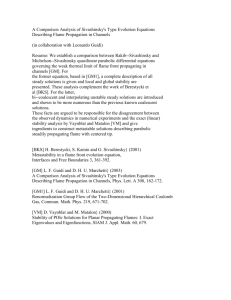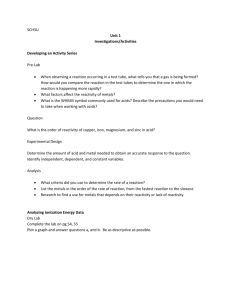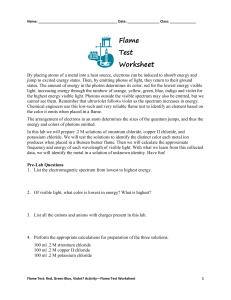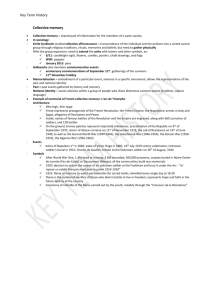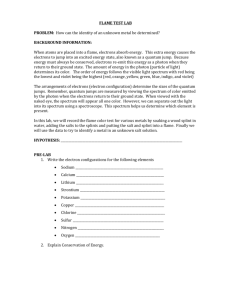Experiment: Flame Tests - Valley Catholic School
advertisement
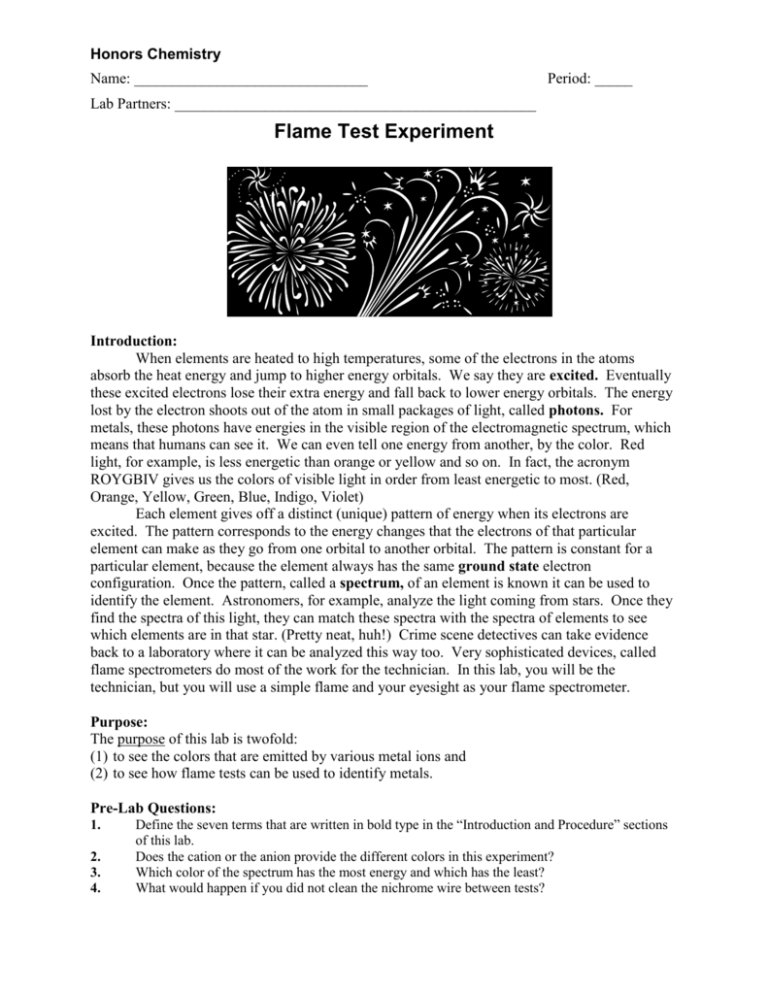
Honors Chemistry Name: _______________________________ Period: _____ Lab Partners: ________________________________________________ Flame Test Experiment Introduction: When elements are heated to high temperatures, some of the electrons in the atoms absorb the heat energy and jump to higher energy orbitals. We say they are excited. Eventually these excited electrons lose their extra energy and fall back to lower energy orbitals. The energy lost by the electron shoots out of the atom in small packages of light, called photons. For metals, these photons have energies in the visible region of the electromagnetic spectrum, which means that humans can see it. We can even tell one energy from another, by the color. Red light, for example, is less energetic than orange or yellow and so on. In fact, the acronym ROYGBIV gives us the colors of visible light in order from least energetic to most. (Red, Orange, Yellow, Green, Blue, Indigo, Violet) Each element gives off a distinct (unique) pattern of energy when its electrons are excited. The pattern corresponds to the energy changes that the electrons of that particular element can make as they go from one orbital to another orbital. The pattern is constant for a particular element, because the element always has the same ground state electron configuration. Once the pattern, called a spectrum, of an element is known it can be used to identify the element. Astronomers, for example, analyze the light coming from stars. Once they find the spectra of this light, they can match these spectra with the spectra of elements to see which elements are in that star. (Pretty neat, huh!) Crime scene detectives can take evidence back to a laboratory where it can be analyzed this way too. Very sophisticated devices, called flame spectrometers do most of the work for the technician. In this lab, you will be the technician, but you will use a simple flame and your eyesight as your flame spectrometer. Purpose: The purpose of this lab is twofold: (1) to see the colors that are emitted by various metal ions and (2) to see how flame tests can be used to identify metals. Pre-Lab Questions: 1. 2. 3. 4. Define the seven terms that are written in bold type in the “Introduction and Procedure” sections of this lab. Does the cation or the anion provide the different colors in this experiment? Which color of the spectrum has the most energy and which has the least? What would happen if you did not clean the nichrome wire between tests? Flame Test Lab Safety: 1. Wear safety glasses and lab apron. 2. Tie back loose hair. 3. Never leave an open flame unattended. 4. Ensure that the gas lines are firmly connected to the Bunsen burner and the gas outlet. 5. Be sure all flammables are fully extinguished before disposal. Procedure: 1. Put on lab apron and safety goggles. 2. Label each of the test tubes with one of the following compounds: LiCl, CaCl2, KCl, CuCl2, SrCl2, NaCl, BaCl2, CoCl2, and unknown. Names of the aqueous solutions: Chemical Symbol Name LiCl Lithium Chloride CaCl2 Calcium Chloride KCl Potassium Chloride CuCl2 Copper (II) Chloride SrCl2 Strontium Chloride NaCl Sodium Chloride BaCl2 Barium Chloride CoCl2 Cobalt Chloride 3. Add 5 mL of each solutions of a metal salt to a different clean test tube. 4. Light the Bunsen burner with the sparker provided. Make sure the flame is blue. You may need to adjust the amount of air or the amount of gas. 5. Clean the nichrome wire loop by dipping it into the hydrochloric acid (HCl) and then into the distilled water and heat the wire in the hottest part of the flame until no color shows. 6. When the nichrome wire loop is clean, dip the wire in the test tube containing an aqueous solution of a metal salt (a metal cation and a chloride/nitrate anion). Hold it in the hottest part of the flame. Record your observation of the color of the flame on the data table. The color will only last a few seconds; record the first color you see in the flame and repeat at least once to ensure you can identify the color. 7. Repeat the process of cleaning the nichrome wire. Now get ready to test another solution. 8. Test all of the solutions and make sure that you record the color of the flame for each element on the Data Table. 2 Revised: 25 Oct 2011 Flame Test Lab 9. Check your flame colors to known results. The teacher will provide the colors for the known results. 10. Once your data table is complete, you are ready to test an unknown. Obtain a sample of unknown solution from the teacher. Perform the flame test on the unknown. Record the color and match the color to one of the metals in the experiment. Write the identity of the unknown on your lab paper. 11. Before leaving the laboratory, wash your hands thoroughly with soap and water. Data: Metal Cation Color of Flame Results: Unknown # _______ Unknown Color ___________ Unknown Identity: _________ Conclusion Questions: 1. Why is light emitted by elements when they are heated? 2. How is this light useful to scientists? 3. Do you think a flame test could be used to identify the metals present in a mixture? Explain. 3 Revised: 25 Oct 2011 Flame Test Lab 4. What would be observed if the light emitted in the flame tests were passed through a prism? 5. Aerial fireworks contain gunpowder and chemicals that produce colors. What elements would you include to produce the following colors? A) crimson red B) yellow C) green 6. Write the full electron configurations for each of the metal cations. 7. List the metallic elements used in the flame tests in order of increasing energy (frequency) of light emitted. Bonus: What is the relationship between the energy of light emitted and the position of the element in the periodic table? 4 Revised: 25 Oct 2011



